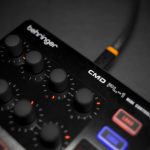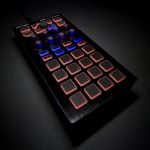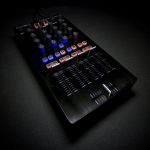Link: CMD DV-1/CMD LC-1/CMD DC-1/CMD MM-1/CMD PL-1
Price: $130/€119/£111
Introduction
I have been waiting for a solid modular DJ solution for a while. I remember the excitement surrounding the release of the Stanton SCS3 line and the sense of acceptance that it was the best I was going to get at the time. Now, all these years later, I have another stack of Behringer CMD modular controller boxes to be excited about getting because I am that many steps closer to building my dream rig, whatever it may be this week.
So I unpacked the five boxes and locked everything together. Just looking at them is kind of overwhelming, and I know it’s going to be difficult to review them in a way that makes sense. While they all have their own use cases and they are also all made from the same stuff.
I am not planning on spending a lot of time discussing the included mappings because while Behringer has worked hard to provide you with as much assistance to take these things out of their boxes and get to work, their real strength is in being utilized based around what you need in your personal rig. Take note, each controller’s mapping in Traktor is set up precisely around what the expected work flow of each individual controller is, not how they work together as a greater whole. The community around these will most definitely invest time into building their perfect combinations, though.
The 5 main modular controllers (the MM-1, DV-1, PL-1, LC-1 and DC-1) are all $129.99 and they all come with Behringer’s 3 year warranty.
Unboxing and First Impressions
All of the controllers are designed the same. They are all anodized aluminum with hard plastic buttons and smooth rubber knobs. All controllers but the MM-1 use exclusively endless encoders with LED rings around them. The rings around the knobs are clear with a small little indicator for position, though they are very close together with some lights almost touching. The MM-1 uses almost all absolute encoders with little white dots to indicate position. The buttons are well-lit between orange (off) and blue (on) (except the LC-1 which also has green and pink). The LEDS can also blink via a MIDI message.
Connecting the units can be a chore, but is so much better than every other solution we have been presented with. The bottom of each controller holds a metal plate with two screws. You unscrew the plates from the bottom of each unit and connect them by screwing the plate back between the two controllers. Compared to the terrible magnets used on the SCS3s this is a godsend. I just wish that the other manufacturers dabbling in modular controls *cough*NI*cough* would take heed of this as connecting these makes moving them so much easier.
Each controller is 6” wide by 12” long and just under 2” high. They come with a TSI file and direct integration into Deckadance 2, and the DC-1, LC-1 and MM-1 all have Ableton scripts for direct integration. Each controller sends on its own MIDI channel (PL-1 on channels 1-4, MM-1 on 5, DC-1 on 6, DV-1 on 7 and LC-1 on 8).
The MM-1
Years ago I wanted nothing more than a simple 4 channel MIDI controller. I didn’t want a full four deck controller, I just wanted something I could put next to the multitude of controllers I was gathering to get the core mixing requirements for four decks. The only option I really had was the ill-fated SCS.1m, and while getting that controller kind of kick started my entire career in the industry it was not what I wanted, and it ended up sitting off to the side after not-too-long. The MM-1, though, is a much more compelling option. It is not crammed full of controls, gives you everything you need for a simple 4 channel mixer.
There are 4 knobs in each channel strip and a 60mm line fader. The top section has four knobs to control the output levels in your software and a small browse section consisting of two buttons labeled left and right and an endless push encoder. The buttons are used in Traktor to scroll through your Explorer, though I would use them to change what the knob scrolls (Browser, Explorer, Favorites). There is a small shift button in the lower middle section of the mixer, in Traktor’s case it allows the Cue button to load tracks. In each channel below the knobs are two mixer buttons and a long cue button. The mixer buttons are used to route FX to the channels but you could use these for anything you wanted.
The faders feel fine, in a stock standard MIDI controller sort of way. I wouldn’t be looking to do any tricks but they definitely will take a hammering before you are done with them. While the controller is very minimal it carries everything you need for mixing. This is not a controller that can handle your entire work flow, but its main purpose is to be used between two other CMD controllers, or in an existing rig consisting of, frankly, anything. You could put this between two Maschine Mikro’s and probably have a massively compelling controllerist rig.
The MM-1 is the only controller with a built-in USB hub, which also requires a power supply to power other connected CMD units.
The DV-1
All these years later a good friend of mine still uses his BCR-2000, and I can’t blame him. Finally Behringer has provided a solution that might not be as powerful as that classic controller, but at least shows they are still serious about utility. The DV-1 has 12 endless rotaries and 39 buttons. There is a whole host of control crammed into this one little box and any creative mapper could have a field day jury rigging this thing to do almost anything they could need.
The most compelling use case for this controller is to sit it right next to any all-in-one DJ controller (like the Studio 4a) and add almost every single command the larger controllers don’t have the real estate for. It is, by far, one of the most complete utility controllers I have ever used. While the buttons are not the most comfortable (like all the rest of the CMD line) there is such a host of control in a small, elegant package that I can really see myself taking advantage of the various extra pieces general manufacturers leave out of their own controllers.
Just keep in mind, with Traktor, the A-D buttons change the deck focus. If you’re setup is, for whatever reason, reliant on deck focus, this may cause you issues.
The PL-1
Much like the MM-1, there are very few controllers on the market that fill the need the PL-1 fills. There are 8 endless knobs, a 60mm 14-bit pitch fader, a 4 inch jog wheel and all the necessary transport controls. While this controller doesn’t cover every need you could have, putting two of these on either side of an MM-1 will provide a solid control scheme for not-too-much-money (approximately $390). The platter is a smaller version of the 4a, but without any of that frustrating extra loose spinning.
The Deck button cycles through 4 different channels (1-4). You can’t change how this interacts, so if you are only using two decks you still need to cycle through decks 3 and 4 to get back to 1 from 2. If you wanted to, though, you could go into the TSI in Traktor, as an example, and change all Decks 3 to 1 and 4 to 2, and you would effectively fake a two channel controller. Since Traktor’s controller manager is not the best thing ever, I would understand you not wanting to take the effort to do that.
The layout is really elegant. The transport buttons are very large, and the mode buttons around the jog wheel are extremely clear. The fact that the jog wheel is just a little stiffer on this controller definitely makes it more useful for simple tricks and just moving around a track. The wheel didn’t give me a lot of issues with simple scratching, and I didn’t notice a lot of drift, at least for simple tricks. It is a small platter, though, and the grip feels funny in the beginning. The platter is loose enough to spin quickly, yet tight enough to stop almost instantly when being spun allowing for very smooth backspins.
The LC-1
While all of these controllers can be used with any application that receives MIDI, the LC-1 is the only one in the pack that looks tailor-made for Ableton’s Session View. There is a good mapping for Traktor as well, but the available commands lend themselves very well for a simple controller to play in Ableton. There are 8 endless encoders and 52 buttons with four color states (orange, blue, green and pink). Effectively you get half a Launchpad + some knobs and mode buttons with an extra color. Unfortunately, the LEDs behind the clip launch buttons have a LOT of bleed amongst them. If a button is off it picks up the surrounding colors and looks, well, really ugly, especially when the blues and pinks clash and make some hideous color combinations.
The buttons suffer from the same issues as the rest of the controllers, namely that they don’t respond uniformly across the whole physical button, and they are not very comfortable to play with. Since this lends itself more toward a performance style controller, I could see getting very tired of using these buttons, especially when there are better solutions for not that much money on the market (the Launchpad 2, for example). That being said, when in Ableton, you have a good host of controls, including Mute/Solo/Record and you can build your own macros using the knobs.
All in all I think that this controller has the least use cases to it, whereas almost everything else can be seriously used in many different instances. The provided Traktor mapping is alright, but I would seriously recommend remapping this to suit your needs and not to even bother with the one that comes with it. I could definitely see this controller being used to take advantage of the new remix deck functionality, but I just wish there was some sort of navigation or browsing section. I know there is only so much space, but it is the only piece that’s missing. Put it next to the DC-1, however, and you can have a really compelling workflow.
The DC-1
And finally, we get to the drum controller. The DC-1 has 8 endless encoders, a browse section consisting of 8 buttons and an endless push encoder, 8 small buttons and 16 large performance buttons/pads. The pads are not velocity sensitive and are made of the same material as all of the other buttons in the line. In comparison to the comparable controllers I’ve used (the F1 and the MIDI Fighter 3D) this one has the most features available with the least amount of needed layers, and I am a huge fan of the layout.
That being said, the buttons are extremely simple. If you mis-hit you will not get a good response, so make sure you’re aiming for the center of the button. This is a problem I experienced with the F1 as well, but not nearly to this level. The LED feedback is bright, though, and the buttons feel like they could take a beating. There is no need to complain about the lack of velocity sensitivity, honestly, because this is really made for cue juggling and possible session juggling in Ableton. I don’t see the need, especially at this price point.
To quell the rumor mill now, though, the DC-1 will work with any DJ Tech Tools MIDI Fighter preset. You won’t get the X/Y joys of the 3D, and it might not be wireless like the Spectra, but it does tap any purchaser into a larger community of mappers to get even more compelling layouts. And, beyond that, there are more controls on the DC-1 than the stock MIDI Fighters, so you can take what’s out there and make it much better for your needs.
The DC-1 is also most appropriate to map to the Remix Decks, now that they allow direct MIDI mapping. It has just about as many controls as the F1 and is set up in a very similar manner. With the experience I’ve had with mapping the remix decks, I’d very much recommend this controller if you don’t want to pay the surplus for the F1. And Behringer is the first company so far to release a MIDI map for the Remix Decks, using the DC-1. While the direct integration of Native Instrument’s offering is definitely useful, the lower price tag and extra buttons (the DC-1 has 8 more buttons than the F1), as well as the ability to develop your own preferred workflow, gives it a slight advantage.
Wrapping It Up
All of that being said these controllers are far from perfect. The absolute knobs do not give a very good indicating position, and the buttons have a mixed response if you don’t hit them right. For the price I can forgive these issues, but I wish they weren’t issues at all. I would not recommend buying all of them unless you’re willing to map, since the provided mappings cover a lot of duplicated commands in Traktor (the DC-1 and the LC-1 both control Key and Filter; the PL-1 and the DV-1 both control FX banks, etc.) and are just screaming to be remapped to fit what any DJ would want.
So having got the gripes out of the way, what are we left with? These are absolutely wonderful controllers for the price. At $129.99 there are so many options for what you may be lacking in your existing rig that doesn’t justify the cost of purchasing another full controller. I would, without a doubt, recommend any of these controllers, depending on what you need for your individual setup. Behringer will be fostering a community of mappers to provide tons of solutions based on individual needs.
Want a compelling 4-deck controller for under $400? Get an MM-1 and two PL-1s, and then remap them so they do all the crazy stuff you want them to do, and then share them with the internet so others can take advantage of them. The true power of these controllers does not lie in the provided mappings and the options on the silk screen, but instead in the open endedness of them, and the ability to lock them together to develop your own personal workflow.
After all of this time DJing on laptops, Behringer has been the manufacturer to finally provide the solutions I have been waiting for.












































